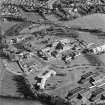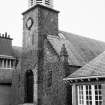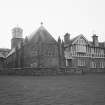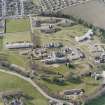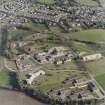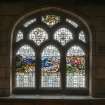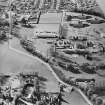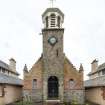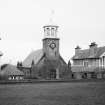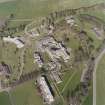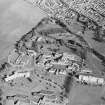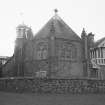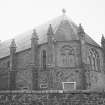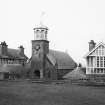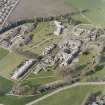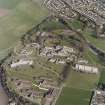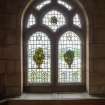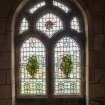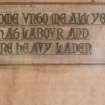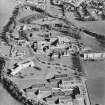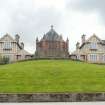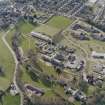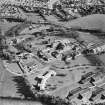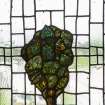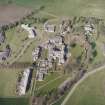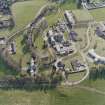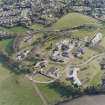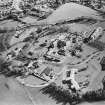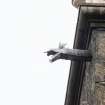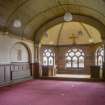Perth, Bridgend, Murray Royal Hospital, Chapel
Chapel (20th Century) (1903)
Site Name Perth, Bridgend, Murray Royal Hospital, Chapel
Classification Chapel (20th Century) (1903)
Alternative Name(s) Kinnoull, Murray Royal Asylum
Canmore ID 127580
Site Number NO12SW 335.01
NGR NO 12890 24077
Datum OSGB36 - NGR
Permalink http://canmore.org.uk/site/127580
- Council Perth And Kinross
- Parish Kinnoull
- Former Region Tayside
- Former District Perth And Kinross
- Former County Perthshire
NO12SW 335.01 12890 24077
4-bay, buttressed, crow-stepped, Gothic chapel with central entrance tower with timber and lead octagonal cupola with tall weather vane and with canted apse to north west. The high base course and tower are cyclopean (polygonal) whinstone and the nave is rock-faced red sandstone. The entrance elevation to the north east has a round-arched central entrance opening with pair of decorative iron gates, and a timber inner door with decorative hinges. There are flanking smaller round-arched window openings. There are crocketted and pinnacled buttresses. Some tracery windows. There are green slates to the roof and the windows are predominantly lead-pane fixed glass. The interior was seen in 2014. The original decorative scheme is largely intact with timber panelling and painted walls to nave, and with bare stone walls to sanctuary. There is a slatted timber, barrel vaulted ceiling and decorative timber pulpit, communion table and lectern. There are some stained glass windows to the sanctuary.
Built in 1903-4 and designed by the chief physician of the hospital, Dr A. R. Urquhart, this chapel is an important part of the development of the Murray Royal Asylum complex. The Gothic-inspired church building is individualistic in style with a cyclopean rubble tower and rock-faced red rubble nave. There is a significant amount of decoration to the exterior of the building, including a timber and lead cupola to the tower and decorative buttresses. Internally, the building is unusual in retaining much of its original decorative scheme and is enhanced by the quality of the materials. The chapel at Murray Royal Asylum was erected in 1904 for the benefit of the patients and the building forms a core part of the asylum complex. It replaced an earlier chapel situated within the main asylum building. The original Murray Royal Asylum building was designed by William Burn and it opened in 1828. This original building is the earliest surviving asylum building in Scotland. It is not known whether there was a chapel in the building initially, but there was one by 1878, when the chapel was described as recently decorated (Draft Heritage Assessment). Care for the mentally ill altered a great deal over the course of the 18th and 19th centuries. Before this, people with mental health problems were generally concealed from society and confined often in harsh conditions. Some were looked after in private 'mad-houses', which were unregulated and where the care varied widely. The first major reform for caring for these patients came from France, particularly Phillipe Pinel (1745-1826) who advocated care and compassion for these patients. These ideas spread to Scotland and the first asylums here, and the Murray Royal was among these, promoted the idea of compassionate care. By the end of the 19th century, attitudes were again changing in the best way to care for the mentally ill. There was a growing understanding that patients would be better looked after in smaller, more domestic settings, rather than the large, institutional settings. Two villas were built as part of this development at the Murray Royal and these lie on either side of the chapel. The chapel was built at this time. Over the course of the 20th century, other buildings were added to the complex, the majority of which have since been demolished. The new Murray Royal Hospital was built in 2010-12 and the original buildings were unoccupied by 2014. Chapels were common additions to large hospital institutions over the course of the 19th century and early 20th century. Some were an integral part of the main hospital building, whilst others, like here, were separate buildings. Hospital chapels were designed to cater for ecumenical worship and at the turn of the twentieth century would often include a variety of architectural styles. A small number still survive from the early 20th century, including those at Bangour, West Lothian (1924) and Gartnavel Royal Hospital, Glasgow (1904). Whilst some retain their original internal features, many have been altered internally and it is unusual for a hospital chapel of this date to have survived with few exterior or interior alterations. In comparison to other chapels of this date, the one at the Murray Royal has some interesting decorative details both externally and internally. Previously listed with the Main Building. Statutory Address amended, (2014). Listed Building Record updated following a review of the former Murray Royal Asylum site, (2014). (Historic Scotland)
Standing Building Recording (22 February 2021 - 1 March 2021)
NO 12879 24062–NO 13113 24009 A historic building survey was carried out from 22 February–1 March 2021, of a number of late 19th- and early 20th-century hospital buildings comprising the former Murray Royal Hospital complex in Perth, prior to the part-demolition and renovation of the buildings. The work was required as a condition of the listed building consent on the development, and included both a basic and enhanced level of historic building survey on the buildings, which included the main Murray Royal Hospital, the Birnam and Elcho Villas, Chapel and Gilgal Building.
The Murray Royal Hospital was constructed in the early 1820s to designs by architect William Burn and was later extended to the NW side in 1833. It was constructed as a lunatic asylum for the people of Perth and the surrounding districts under the will of James Murray of Tarsappie. After the 1830s extensions, it comprised a typical H-Plan hospital with a central administration wing with wards for female and male inpatients to the SW and SE sides, with additional wards to the NW added in 1889. In 1903–1904, two identical detached villas were constructed to the NW of the hospital – the Elcho and Birnam Wings – together with a small chapel between them. At the same time, a sub-basement walkway was also created between the Chapel and the main hospital building. In the early 1930s, another larger detached building known as the Gilgal Building was constructed further to the SE of the hospital for voluntary inpatients.
The layout of the main hospital building is defined by its
large circulation area to the SE side of its central wing, which is located below an octagonal tower rising above the roof with a glazed cupola added in the 1850s. Decorative wrought iron railings adorn the upper second and attic floor levels creating a walkway. There are some late 19th-/early 20th-century detailing in the building, such as the timber panelled doors, cornices and decorative ceilings, together with some survival of cast- iron fireplaces. However, the more elaborately decorated rooms in the building are located at the second floor level in the NW side, consisting of a library with fine joinery and timber detail, and a ballroom. Both rooms have been subject to severe damp and mould in recent years, although much of their original character has been retained.
The Elcho and Birnam Wings are virtually identical and
in opposite symmetry built in an Arts and Craft style with a half-timbered first floor. The Chapel, located between these buildings, has a Nave and Sacristy to the NW side with a small basement area. The Chapel was designed by A R Urquhart in a Scots Gothic style with a plain pitched slate roof and tower at the SE font. This, and the adjacent villas, were all built on a large elevated piece of land with an uninterrupted view of the landscape.
The Gilgal building was constructed in 1930 and designed by architects Smart, Stewart and Mitchell as a detached hospital to the SE of the main hospital building for voluntary inpatients. From the 1990s, a new hospital complex was erected to the NW of the older hospital which eventually became derelict.
In the last few years, the main building has been subject to roof material theft which has led to a severe damp problem in many areas of the building. A fire also gutted the Gilgal building in 2011, which meant that the interior of that building was inaccessible at the time of survey due to health and safety concerns.
Archive: NRHE (intended) Funder: Riverside Residential
Diana Sproat – AOC Archaeology Group
(Source: DES Vol 22)
OASIS ID: aocarcha1-419260
Photographic Survey (26 May 2021)
MURRAY ROYAL HOSPITAL CHAPEL was recorded as part of the Threatened Buildings Survey on 26th May 2021 prior to their proposed redevelopment.
The Hospital Chapel was designed by Dr A R Urquhart, the chief physician of the hospital and built 1903-4. He was presumably assisted by Maclaren and Mackay who were the architects for the flanking Elcho and Birnam Villas which were constructed at the same time. The three stained glass windows in the apse of the Chapel are early works by Douglas Strachan depicting the Good Samaritan. He was probably also responsible for the other stained-glass window in the chapel depicting the Dove descending with angels. Although the seating had been removed at the time of survey the chapel retains its original organ, pulpit and lecturn. The exterior is adorned with a fine weathervane and distinctive metal waterspout in the form of a dragon’s head
The James Murray bequest that originally funded the Murray Royal Hospital came from the proceeds of wealth created overseas through Scotland’s Colonial enterprise.











































